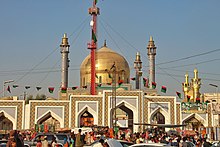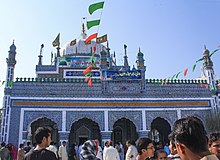Sufism in Sindh covers the tradition of Sufism in Sindh, which is reputed to be an area of mystics. Sindh is famous for the enormous number of saints and mystics who lived there and preached peace and brotherhood. According to popular legend, 125,000 of them are buried on Makli Hill near Thatta. There is an abundance of Sufi literature produced in Sindh throughout history.
History
Early Period
Abdullah Shah Ghazi was a Muslim mystic and one of the earliest Sufis in Sindh who came from Arabia. His father, Muhammad al-Nafs al-Zakiyya, was a descendant of the Islamic prophet Muhammad through his daughter Fatimah.
The mystic Husain ibn Mansur al Hallaj, who is credited with the utterance Anal Haqq ("I am The Creative Truth"), reached Sindh in 905, proceeding from Gujarat. He travelled extensively throughout Sindh and discussed theological matters with local sages. He inspired many poets and musicians in the region. Sachal Sarmast was one of the greatest admirers of Mansur Hallaj and pays homage to him in his poetry frequently.

In 12th Century, a new wave of Sufi Mystics came to South Asia, these included Mu'in al-Din Chishti who brought the Chishtiyya order to South Asia, Lal Shahbaz Qalandar, a Sufi saint from Sindh itself and founder of the Qalandariyya order, Baha-ud-din Zakariya, a Sunni Muslim scholar saint and poet who established the Suhrawardiyya order of Baghdad in medieval South Asia, Baba Farid, a mystic, poet and preacher and Jalaluddin Surkh-Posh Bukhari.
Bahauddin Zakariya, Lal Shahbaz Qalandar, Baba Farid and Syed Jalalauddin Bukhari, together became known as the legendary Haq Char Yaar, or "Four friends" group. Friendship of these famous Sufi saints who were preaching in different regions of South Asia at that time helped spread Sufism in Sindh.
Sufi Saints like Pir Mangho and Bodla Bahar were disciples of Baba Farid and Lal Shahbaz Qalandar who were greatly inspired by them and continued to spread Sufism in Sindh in 13th Century.
Middle Period

By 15th Century, Sindh started producing many Sufi saints and poets of its own such as Makhdoom Bilawal and Qazi Qadan of Bukkur who is also known as "The Father of Classical Sindhi Poetry".
Under Mughal Empire, Sindh saw a large number of Sufi Saints and poets these included Shah Abdul Karim Bulri, a Sufi Poet who was also the great-great-grandfather of another famous Sufi poet Shah Abdul Latif Bhittai, Shah Inat Rizvi, Bibi Jamal Khatun, a female Sufi saint whose mother was daughter of Qazi Qadan and Shah Inayat Shaheed, another saint of Sindh who was executed on the orders of Mughal Emperor Farrukhsiyar.

By 18th Century, Sufism had reached its high point in Sindh due to the poetry of Sufi Saints like Shah Abdul Latif Bhittai, Khawaja Muhammad Zaman of Luari, Mir Janullah Shah, Rohal Faqir and Sachal Sarmast.
Later Period
By 19th Century, Mughal Empire started declining and Sindh also saw a decline in Sufi poets and Saints. Some famous Sufi Saints and poets of this era from Sindh were Faqir Qadir Buksh Bedil and his son Muhammad Mohsin Bekas, Syed Misri Shah, Pir Hadi Hassan Bux Shah Jilani, Sufi Budhal Faqeer, Nadir Ali Shah, Khwaja Abdul Ghaffar Naqshbandi and Mewa Shah.
Modern Era
Sufism has become a primary marker of Sindhi identity for both Muslims and Hindus. Sufism ideology is continued to be practiced by locals even though some terrorists have tried to attack sufism by attacking modern sufis like Sayyid Ghulam Hussain Shah Bukhari and shrines like the one in Sehwan Sharif which was the site of a suicide bombing in 2017 carried out by the Islamic State.
Sufi Music
According to Michel Boivin, music is inseparable from Sufi poetry in Sindh.
The author of the Akbarnamah wrote that the kafi music originated from Sindh. The art of 'musical narration' had received patronisation under the Soomra dynasty of Sindh and was further developed and patronised under the Sammahs.
The most renowned Sindhi genre of poetry is the kafi which, according to Annemarie Schimmel, is accompanied by instruments and is a vehicle of mystical songs. Shah 'Abd al-Latif is seen as the greatest renovator of Sufi music in Sindh.
The philosophy of Persian poets deeply influenced Sindhi Sufistic thought and poetry. During Muslim rule in Sindh, the works of Rumi, Attar, Jami, Khayyam, Saadi and other poetic Persian mystics were keenly studied by both Hindu and Muslim scholars. Sachal was deeply influenced by Attar. Shah Abdul Latif was influenced by Maulana Jalaluddin Rumi.
Shrines of Sufi Saints in Sindh
| Shrine of | Era C.E. | Tomb | City | Photo |
|---|---|---|---|---|
| Abdullah Shah Ghazi | 720-773 | Clifton | Karachi | 
|
| Sayyid Muhammad Al-Makki | 1145-1246 | Arak Fort, Bukkur | Sukkur | 
|
| Syed Muhammad Usman (Lal Shahbaz Qalandar) | 1177-1274 | Sehwan Sharif | Jamshoro District | 
|
| Bodla Bahar | 1238-1298 | Sehwan Sharif | Jamshoro District | |
| Pir Mangho | 13th century | Gadap Town | Karachi | 
|
| Makhdoom Bilawal | 1451-1522 | Baghban (near Dadu City) | Dadu District | 
|
| Shah Abdul Karim Bulri | 1536-1623 | Bulri | Tando Muhammad Khan District | 
|
| Shah Inayat Shaheed | 1655-1718 | Jhok Shareef | Sujawal Districtl | |
| Khawaja Muhammad Zaman | 1713-1775 | Luari Sharif | Badin District | 
|
| Shah Abdul Latif Bhittai | 1689/1690-1752 | Bhit Shah | Matiari District | 
|
| Sachal Sarmast | 1739-1829 | Daraza | Khairpur | 
|
| Qalandar Baba Auliya | 1898-1979 | Shadman Town | Karachi | |
| Pir Hadi Hassan Bux Shah Jilani | 1846-1900 | Duthro Sharif | Sanghar District | 
|
| Nadir Ali Shah | 1897-1974 | Sehwan Sharif | Jamshoro District | 
|
See also
References
- Annemarie Schimmel, “Sindhi Literature,” A History of Indian Literature Wiesbaden, Germany: Otto Harrassowitz (1974). See pp. 10.
- ^ Naz, H., D.R. (2015). Significance of the Malfuz Literature as an Alternative Source of History: A Critical Study on the Tadhkirat Al-Murad as the Earliest Malfuz Compiled in Sindh. Pakistan Historical Society. Journal of the Pakistan Historical Society, 63(2), 83-99.
- Annemarie Schimmel, Pearls from Indus Jamshoro, Sindh, Pakistan: Sindhi Adabi Board (1986). See pp. 150.
- ^ Lal, Mohan. Encyclopaedia of Indian Literature: sasay to zorgot. Vol. 5. Sahitya Akademi, 1992.
- "Abdullah Shah Ghazi, Karachi". heritage.eftsindh.com. Retrieved 2024-08-10.
- Butt, Asim (11 August 2005). "Pakistan's mystical Islam thrives". BBC News. Archived from the original on May 8, 2009. Retrieved 2 December 2023.
- Ali, Saleha (2023-10-17). "All You Need to Know About Abdullah Shah Ghazi Shrine". Graana.com. Retrieved 2024-08-10.
- Hanif, N. Biographical encyclopaedia of sufis: South Asia. Vol. 3. Sarup & Sons, 2000.
- Annemarie Schimmel, Pearls from Indus Jamshoro, Sindh, Pakistan: Sindhi Adabi Board (1986). See pp. 5.
- Masood Lohar (2004-10-05). "Saint revered by people of all religions". Dawn (newspaper). Retrieved 20 March 2021.
- Encyclopedia Sindhiana volume 4, Sindhi language Authority, 2010, p. 200
- ڊاڪٽر نبي بخش خان بلوچ (2019-10-21). قاضي قادن جو رسالو ڊاڪٽر نبي بخش بلوچ.
- Shackle, Christopher (2012). "ʿAbd al-Karīm". In Fleet, Kate; Krämer, Gudrun; Matringe, Denis; Nawas, John; Rowson, Everett (eds.). Encyclopaedia of Islam (3rd ed.). Brill Online. doi:10.1163/1573-3912_ei3_COM_24148. ISSN 1873-9830.
- Ernst, Carl W. (2010). "Bībī Jamāl Khātūn". In Fleet, Kate; et al. (eds.). Encyclopaedia of Islam (3rd ed.). Leiden: Brill. doi:10.1163/1573-3912_ei3_COM_23436. ISBN 9789004183902.
- The socialist Sufi and the Jhok war Dawn (newspaper), Published 20 July 2014, Retrieved 4 December 2021
- "Sindhishaan - Essence of Sindh". sindhishaan.com. Retrieved 2024-08-11.
- Judy Wakabayashi; Rita Kothari (2009). Decentering Translation Studies: India and Beyond. John Benjamins Publishing. pp. 132–. ISBN 978-90-272-2430-9.
- "Cleric targeted in Jacobabad last week teaches only the message of peace". Daily Tribune.com.PK. 24 February 2013. Retrieved 30 June 2014.
- "Sehwan bombing toll reaches 88, over 250 injured". The News. 17 February 2017. Retrieved 17 February 2017.
- ^ Boivin, Michel. "Devotional Literature and Sufism in Sindh in the Light of Dr. NB Baloch's contribution." Journal of the Pakistan Historical Society 9.4 (2012): 13-23.
Further reading
- Ansari, Sarah FD. Sufi saints and state power: the pirs of Sind, 1843-1947. No. 50. Cambridge University Press, 1992.
| Sufism by country | |
|---|---|
| Countries | |
| Sindhi Sufis | |
|---|---|